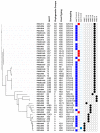Genomic Characterization of Uropathogenic Escherichia coli Isolates from Tertiary Hospitals in Riyadh, Saudi Arabia
- PMID: 37108743
- PMCID: PMC10141978
- DOI: 10.3390/ijms24087582
Genomic Characterization of Uropathogenic Escherichia coli Isolates from Tertiary Hospitals in Riyadh, Saudi Arabia
Abstract
Uropathogenic Escherichia coli (UPEC) is the most common cause of urinary tract infections (UTIs) in hospitalised and non-hospitalised patients. Genomic analysis was used to gain further insight into the molecular characteristics of UPEC isolates from Saudi Arabia. A total of 165 isolates were collected from patients with UTIs between May 2019 and September 2020 from two tertiary hospitals in Riyadh, Saudi Arabia. Identification and antimicrobial susceptibility testing (AST) were performed using the VITEK system. Extended-spectrum β-lactamase (ESBL)-producing isolates (n = 48) were selected for whole genome sequencing (WGS) analysis. In silico analysis revealed that the most common sequence types detected were ST131 (39.6%), ST1193 (12.5%), ST73 (10.4%), and ST10 (8.3%). Our finding showed that blaCTX-M-15 gene was detected in the majority of ESBL isolates (79.2%), followed by blaCTX-M-27 (12.5%) and blaCTX-M-8 (2.1%). ST131 carried blaCTX-M-15 or blaCTX-M-27, and all ST73 and ST1193 carried blaCTX-M-15. The relatively high proportion of ST1193 in this study was notable as a newly emerged lineage in the region, which warrants further monitoring.
Keywords: Saudi Arabia; antimicrobial resistance; extended-spectrum β-lactamases; molecular typing; urinary tract infection; uropathogenic E. coli; whole-genome sequence.
Conflict of interest statement
The authors declare no conflict of interest, H.H.B. has been part of this work during her previous tenure as Professor of Pediatric infectious disease at KSAU-HU and Chairman of the infectious disease research department at KAIMRC.
Figures
References
-
- John A.S., Mboto C.I., Agbo B. A review on the prevalence and predisposing factors responsible for urinary tract infection among adults. Eur. J. Exp. Biol. 2016;6:7–11.
-
- Bunduki G.K., Heinz E., Phiri V.S., Noah P., Feasey N., Musaya J. Virulence factors and antimicrobial resistance of uropathogenic Escherichia coli (UPEC) isolated from urinary tract infections: A systematic review and meta-analysis. BMC Infect. Dis. 2021;21:753. doi: 10.1186/s12879-021-06435-7. - DOI - PMC - PubMed
MeSH terms
Substances
Grants and funding
LinkOut - more resources
Full Text Sources
Medical


